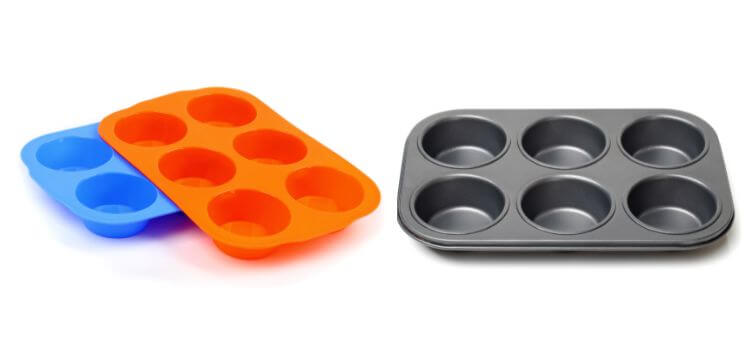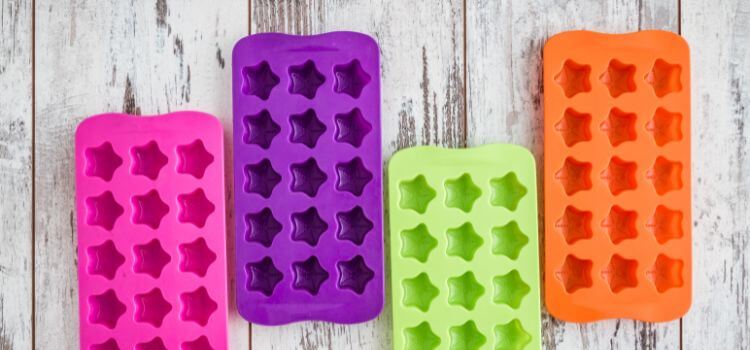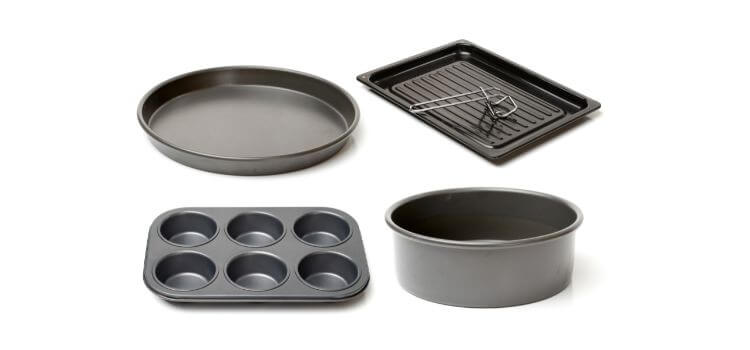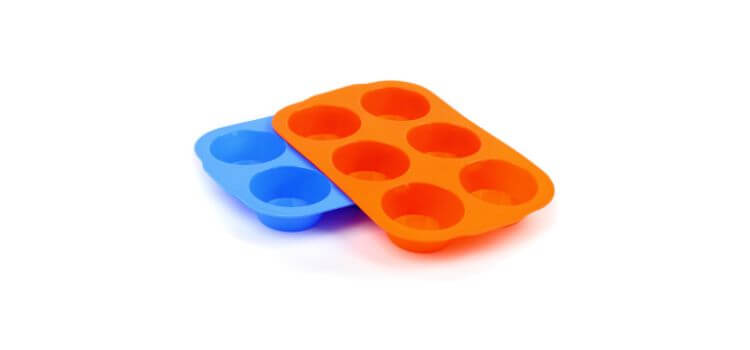As an Amazon Associate, I earn from qualifying purchases

Choosing silicone molds and metal pans in baking can significantly impact your culinary creations. Understanding the nuances of baking in silicone molds versus traditional metal pans is crucial for achieving baking success.
In this article, we explore the pros and cons of each option and their effects on the texture, appearance, and overall quality of your baked goods. Whether you’re an experienced baker or a novice, making informed choices about your tools can significantly enhance your baking skills.
Silicone Molds For Baking

Silicone molds have surged in popularity in recent years, and rightfully so. These flexible, non-stick molds offer several advantages over traditional metal pans.
Advantages of Silicone Molds
- Non-stick surface: Unlike metal pans that often require greasing or lining with parchment paper, silicone molds have a naturally non-stick surface. This makes unmolding your baked goods a breeze and reduces the risk of your creations sticking to the pan.
- Flexible: Silicone molds are incredibly flexible, perfect for intricate designs and delicate treats like cupcakes and custards. The flexibility to bend and twist the mold ensures effortless removal of your creations, preserving their shapes perfectly.
- Heat distribution: Silicone is a superb heat conductor, ensuring your baked goods cook evenly without any hot spots. This is particularly beneficial for delicate pastries and cakes that require precise temperature control.
Disadvantages of Silicone Molds
- Lack of browning: One downside of silicone molds is their lack of browning capabilities. Unlike metal pans, which promote browning due to their ability to absorb heat, silicone molds do not allow the browning of your baked goods. This may result in pale and unappetizing-looking treats.
- Not heat-resistant: While silicone molds are suitable for most baking tasks, they are not entirely heat-resistant. Extreme temperatures can cause them to melt or warp, rendering them unsuitable for high-heat cooking methods such as broiling or grilling.
Basic Statistics Of Silicone Molds
- Silicone molds are made from silicon (a naturally occurring element) and oxygen.
- They have a high melting point, usually between 428-464°F (220-240°C), making them suitable for most baking temperatures.
- They come in various colors, but it is essential to choose light-colored molds as dark-colored ones may absorb more heat and cause over-browning.
Silicone Mold Types
Various silicone mold types are available in the market, each with unique features and uses. Some common ones include:
- Silicone Cupcake Molds: These molds are available in various sizes and shapes, making them ideal for baking cupcakes, muffins, and other individual-sized treats.
- Silicone Cake Pans: Silicone cake pans are ideal for creating intricate cake designs, thanks to their flexibility and non-stick surface.
- Silicone Bundt Pans: These pans are perfect for making bundt cakes with beautiful patterns and designs.
Metal Pans For Baking

Metal pans have long been the go-to choice for baking enthusiasts. These traditional pans come in different shapes and sizes, making them suitable for baking.
Advantages of Metal Pans
- Promotes browning: As mentioned earlier, metal pans promote browning by absorbing heat and distributing it evenly. This results in beautifully browned baked goods with a crispy exterior.
- Heat-resistant: Unlike silicone molds, metal pans can withstand high temperatures and are suitable for broiling and grilling recipes.
- Affordable: Metal pans are generally more affordable than silicone molds, making them a budget-friendly option for bakers.
Disadvantages of Metal Pans
- Sticking issues: One common issue with metal pans is that baked goods stick to the surface, especially if not properly greased or lined. This can be frustrating and may result in damaged treats.
- Uneven heat distribution: Metal pans can have hot spots, leading to uneven baking if not properly monitored. This is why it’s essential to rotate your pans during baking.
Basic Statistics Of Metal Pans
- Metal pans are usually made from aluminum, stainless steel, or carbon steel.
- They have a lower melting point than silicone molds, with aluminum having the lowest melting point at around 1220°F (660°C).
- They come in various shapes and sizes, making them suitable for different baking needs.
Metal Pan Types
Some common types of metal pans used for baking include:
- Aluminum Pans: These are lightweight and an excellent conductor of heat, making them perfect for delicate cakes and pastries.
- Stainless Steel Pans: These are durable, heat-resistant, and easy to clean. They are suitable for a wide range of baking tasks.
Baking In Silicone Molds vs Metal: Which is Better?

The answer to this question ultimately depends on personal preference and the type of recipe you’re making. Both silicone molds and metal pans have their advantages and disadvantages, but here are some general guidelines to help you decide:
- For delicate treats: If you’re making intricate designs or delicate treats like cupcakes, custards, or flans, silicone molds are the better option due to their flexibility and non-stick surface.
- For browning: Metal pans are the way to go if you want beautifully browned baked goods. Their ability to promote browning is unmatched by silicone molds.
- For high-heat recipes: Metal pans are the safer choice if your recipe calls for high temperatures or broiling/grilling, as they can withstand extreme heat.
- For budget-friendly options: If you’re on a tight budget, metal pans are generally more affordable than silicone molds.
- Baking time: Silicone molds tend to have shorter baking times than metal pans due to their heat-conducting properties. Keep this in mind when deciding which one to use.
- Price: Silicone molds, a newer baking tool, are more expensive than metal pans. Metal pans are the more cost-effective option if you’re just starting with baking or don’t want to invest too much money.
Conclusion
In conclusion, both silicone molds and metal pans offer distinct advantages and disadvantages, and your choice will ultimately depend on your personal baking preferences. Before deciding, consider the recipe, browning capabilities, heat resistance, and price.
Whichever option you go for, remember to always grease or line your pan before using it to avoid any sticking issues. Happy baking!
As an Amazon Associate, I earn from qualifying purchases
Pingback: Cake Pan vs Pie Pan